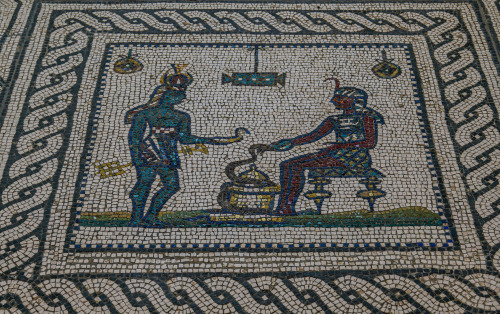
calopsia-sunshine
completely new here and have no idea what i'm doing. archaeology major, classical art fanatic, history nerd, and fantasy lover.
51 posts
Latest Posts by calopsia-sunshine
"are you team green or team black on house of the drago-" i'm on the girls team. all the women on the show deserve to be picked up and transported to a place far far away from the pathetic little men on this show. all of the girls are valid and right. i will defend all of them to the death

Jason and Medea (1907) by John William Waterhouse

lord take all of their suffering & give it to criston cole



![Title: Saint Margaret Artist: Joan Reixach (Spanish [Catalan], Ca. 1411 - 1486/92) Date: Ca. 1456 Genre:](https://64.media.tumblr.com/6f0b28a89cbefeff2acdb5663900b72f/639a93c81ca0865f-7c/s640x960/dd21dea638c1e09105e684be41d32ef633c852c0.jpg)
Title: Saint Margaret Artist: Joan Reixach (Spanish [Catalan], ca. 1411 - 1486/92) Date: ca. 1456 Genre: religious art Medium: tempera, oil, and gold leaf on wood Dimensions: 123 cm (48.4 in) high x 65 cm (25.6 cm) wide Location: Museu Nacional d'Art de Catalunya, Barcelona, Spain










love as religion
jorge luis borges // ron padgett // richard siken // halsey // lana del rey // caitlyn siehl // hozier // katherine philips













Apropos of nothing, here is a baker's dozen images of bird-shaped brooches ca. 6th century, from Frankish, Vendel, and Anglo-Saxon artisans. They all come from the Metropolitan Museum of Art collection on JSTOR, which includes nearly half a million open access images for everyone!



Daenerys Targaryen (Daemon's vision) in HOUSE OF THE DRAGON S02E08 | "The Queen Who Ever Was"

French Novels and Rose (1888) by Vincent van Gogh

Sir Lawrence Alma-Tadema, My Sister Is Not In
The Tarsus Medallions
Pictured below is one of the three medallions found in the "Treasure of Tarsus", this one depicting Alexander the Great on the obverse and Alexander on horseback spearing a lion.

The Tarsus medallions were found near the ancient city of, you guessed it, Tarsus in the 19th century and are most likely victory medallions for the winners of Pythian and Olympic games held during imperial visits. The Tarsus examples were probably struck during the Reign of Severus Alexander, who could've participated in a cult surrounding Alexander the Great, hence his depictions on the medallions. From what I've seen there were only 3 of these types found in the treasure, but some sources say 4. French Wikipedia has a medallion of distinctly different style from the Rome mint depicting Severus Alexander that was supposedly found with the other three, but it doesn't really fit in with the others.

Pictured above, obverse depicts a portrait of Alexander (not Herakles apparently) wearing the remains of the Nemean lion with the reverse being the same as the first medallion.

By far my favorite of the three, this one depicts Philip II, the father of Alexander on the obverse, with the reverse depicting victory leading a quadriga.

Roman fresco , early 1st century, depicting a greek legend. Dionysus being breastfed by Macris, one of his nurses, and the nymphs of Mount Nysa. From Villa Farnesina. National Archaeological Museum, Rome.

Bowl of Strawberries, c.1620 by Sebastian Stoskopff (French/German, 1597–1657)




These ancient Roman wall paintings, from Pompeii and Stabiae, are like "photographs" taken more than 2000 years ago as they depict villas and landscapes of the area.
@ancientcharm






Beautiful colors from Ancient Rome
Mosaic plaque fragments from late Roman Republic

Artist’s model strikes a pose in a Montmartre studio
National Geographic | June 1960


#this is my aesthetic


The mosaic floor of a dining room in a Roman villa in Antandros in Anatolia, which was occupied between the 3rd and 6th centuries AD.


Game of Thrones 1.10 | House of the Dragon 2.01

—Fyodor Dostoevsky


Mosaic floor with Egyptianizing Scene. From Prima Porta (Rome) 2nd century
Metropolitan Museum of Art
Photo: © Ozymandias (Flickr)

Monumental marble statue of Athena (Minerva) found in one of the most important rooms of the Villa of the Papyri, Herculaneum.
National Archaeological Museum of Naples. Photo: Giorgio Albano

Satan Enthroned in Hell (Samuel Colman, 1832 - 1920)





The Temple of Aphaia (Aegina), Greece
The nymph Aphaia was worshipped on the island of Aegina (Aigina) since the 2nd millennium BC, and only there. She was thought of as the daughter of Zeus and was similar to the virgin goddess Artemis. Like Artemis, Aphaia protected women in childbirth. Her temple was a place principally of female cult.

Nikita Gill, from Fierce Fairytales Poems & Stories to Stir Your Soul; "Why Tinkerbell Quit Anger Management,"

Lamia and the Soldier (1905) by John William Waterhouse

![Artemisia Gentileschi. (c. 1627). Lucretia. [Oil On Canvas]. Getty Center, Los Angeles, CA.](https://64.media.tumblr.com/ac99f2cffe74e74377ca93c599fffe4f/e968a6475a3c0d86-73/s500x750/a8d6b867dfde7b8f3f7f3e8780decf0f11a59f74.jpg)
Artemisia Gentileschi. (c. 1627). Lucretia. [Oil on Canvas]. Getty Center, Los Angeles, CA.


The Ecstasy of Beata Ludovica Albertoni, Gian Lorenzo Bernini, 1671-74